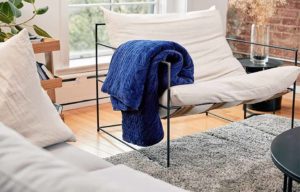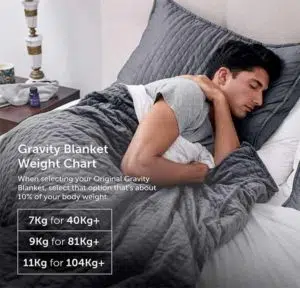Weighted blankets are divisive: you either love ‘em or you hate ‘em. Which side are you on?
Once only a tool of therapists and psychiatry clinics, now you can find weighted blankets while perusing the aisles of your local Target, in between the towels and trinkets.
Weighted blankets, also known as gravity blankets, aren’t decorative or meant to keep you warm. They’re therapeutic. They help ease anxiety and create a sense of safety. They provide proprioceptive feedback to your muscles and joints to facilitate relaxation. That’s a fancy way to say your muscles talk to your brain and say, “we’re OK.”
In laymen’s terms: they cuddle you so you can relax.
These heavy blankets provide deep-touch pressure. They have long been used in sensory integration therapy. Weighted blankets are prescribed for people who lack sleep due to insomnia, restlessness, have anxiety, autism, ADHD, psychiatric disorders, autoimmune issues, fibromyalgia, chronic pain, and more. In autism and ADHD, this treatment is sometimes used to help people focus on sensory experiences, which experts say may boost these individuals’ ability to regulate their emotions and behavior.
People with chronic autoimmune issues that affect the joints and muscles, like rheumatoid arthritis, Hashimoto’s, fibromyalgia, and chronic fatigue syndrome, often find relaxation and calm under a weighted blanket. (Hey, that’s me!)

How do Weighted Blankets Work?
In short: weighted blankets tell your body that you’re safe. You can read more about why that’s important here.
The blankets are heavy. They’re literally their name: weighted. They have quilted pockets sewn into them where small dense clay, glass, or steel beads are stitched into them. Newer technologies use a woven chain layer (my personal preference!) The blankets are crafted to minimize shifting of fillings and help ensure an even and uniform layer of weight and thickness throughout. They can be anywhere from 10lbs to 50lbs. You’ll want one based on your body weight, which we’ll get to.
Weighted blankets produce something called a “deep-pressure touch.” It’s the same tactile sensory input you get from holding, stroking, cuddling, hugging, and squeezing. It stimulates the release of serotonin and dopamine, two neurotransmitters that make people feel relaxed.
Research suggests that slow and gentle touch can stimulate the limbic system, the brain’s network for processing emotion and fear. This sensory input tells your brain and body that you’re safe, it’s OK to relax, and turns off the flight or fight response. Many people with sensory-processing disorders are hypersensitive to touch, and deep pressure can help desensitize and calm them.

How do you know if a weighted blanket is right for you?
As someone who has chronic autoimmune issues, I find them especially helpful for joint and body pain. However, my dad, who suffers from severe nerve damage, described it as being in a coffin at the dentist’s office. So, who’s it right for?
Let’s start with how you currently sleep: If you enjoy snuggling into a heavy blanket to get to sleep, you just might like a weighted blanket to help you relax deeply. If you’re the type of person who likes a lightweight duvet or to draped in only a sheet, weighted blankets probably will feel suffocating and cause anxiety, the opposite of their intention.
I had a pretty good idea that weighted blankets were going to work for me because I don’t like “light touch” sheets and quilts and have always preferred heavy, beefy blankets when I sleep. Even in the summertime, I use a light cotton blanket with a surprising amount of heft.
Getting Started with Weighted Blankets:

- Weight: The weight should not exceed 10% of your body weight.
- Like a fish: Most people take to them immediately and they can be used to cover the entire body on the first use. Some prefer smaller versions that only cover targeted areas like their chest and hips.
- Need focus at work or school? Lap versions are used to help with attention and focus.
- Feeling a little anxious? If you have an adverse reaction and feel anxiety while under the blanket, try to introduce the blanket slowly. Place it across your hips or legs(s) until you’re acclimated. Then roll it out more and more until you’re covered.
- Feeling suffocated? If you continue to feel uncomfortable, claustrophobic, or anxious, weighted blankets aren’t for you. You may not be a sensory seeker and instead this input feels noxious to your muscle sense, rendering the opposite effect.
Weighted blankets for an autoimmune flare-up:
Personally, as someone who has multiple autoimmune issues, a weighted blanket has become part of my protocol for flare-ups. I use them when I have been “glutenized” or have a gluten cross-reaction, or I am having a Rheumatoid Arthritis or Hashimoto’s flare-up. During my flare-ups, my skin becomes sensitive to touch, and my joints and body ache for days or weeks. I become sensitive to light and noise. It’s like having a whole-body hangover and migraine.
I take magnesium to soothe my muscles and relax my body, then I lay down flat on my bed under my gravity blanket for 20 minutes. I do breathwork, meditations, or visualizations during this time. I like it as quiet and dark as possible, occasionally wearing an eyemask or putting a pillow on my eyes for added dampening of sound and light. My blanket is 15lbs, 6’ long, and 4’ wide — it just fits the length of my body (I’m 5’10”) laying flat and straight, or as a lap blanket when I’m sitting. I especially like that it’s organic cotton and has a glass bead mesh, so I don’t hear anything and it doesn’t shift around.
But do they work?
With all healing modalities, it’s very personal. I’m a proponent of bio-individuality and that there is no one-size-fits-all approach to healing. There is only try (with effort) and see if it has positive effects for you. Me? I love ’em.
Research hasn’t been able to conclude decisively on their effectiveness. There have been a number of studies that show they are relaxing, soothing, and therapeutic, and others show no difference. Some studies suggest a placebo effect and others that the act of relaxing itself is what’s doing the work.
A study for insomnia with psychiatric disorders was very positive. For 4 weeks, 120 people with psychiatric disorders such as major depressive disorder, bipolar disorder, generalized anxiety disorder, or attention deficit hyperactivity disorder, used a weighted blanket for insomnia. It resulted in significantly better sleep, a higher daytime activity level, and reduced daytime symptoms of fatigue, depression, and anxiety. Even after a year, those continuing to use weighted blankets maintained the effect on sleep and saw improving daytime symptoms and levels of activity.
So what’s the bottom line on weighted blankets?
Bottom line, even if 40% can be attributed to the placebo effect, any experience of feeling better is real and worthwhile. Especially when it’s safe, non-toxic, and has no serious adverse effects.
I would however proceed with caution for kids. Don’t use them on kids younger than 7 or 8 and consult a therapist.
For adolescents and adults, weighted blankets are unlikely to do any harm — but maybe try burrowing under your pre-existing stash of quilts and duvets to see how you feel before you lay out all that cash.





